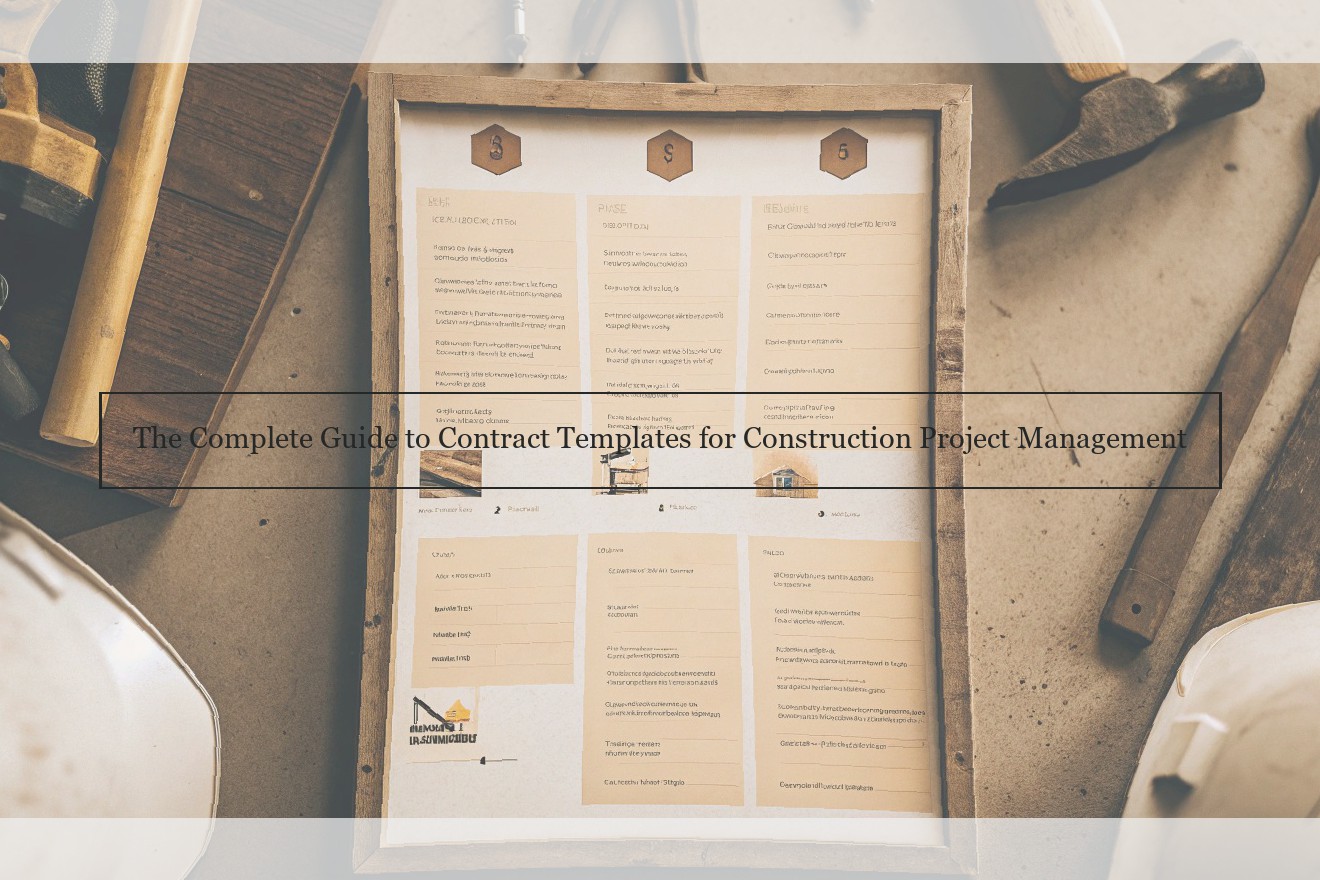What is a Construction Project Management Contract?
Construction project management contracts are legal documents that spell out the terms between stakeholders during a construction project in a way that is mostly free of ambiguity and confusion. These contracts are standardized documents that help to ensure efficiency and reduce uncertainty in the multitude of interactions that occur during such a project. The level of detail included in the contract depends on how much interaction will be needed between the stakeholders.
A construction project management contract encompasses much of what is covered in standard construction contracts, but augments that with a broader scope . While construction contracts only cover the parties that have direct contractually obligations to each other, a construction project management contract can also cover those who do not yet have an agreement but who will benefit from being included in some of the more elusive aspects of the project.
In particular, without the use of a construction project management contract, you would likely have to spend the majority of your time communicating with the General Contractor. Rather than dealing with the details directly, the GC would typically be the person communicating with subcontractors and suppliers to confirm specific requirements or make necessary changes. By using a construction project management contract with key stakeholders, you may be able to create a more efficient process by relieving some of the communication strain off of the GC.
Key Components of Construction Project Management Contract
A construction project management contract is similar to any other contract in that it will have a scope of work, a timeline, costs and parties responsible for completing various tasks. The contract should indicate whether the property is privately held or publicly held, as this has implications regarding public bidding processes. Any bonding, licensing and insurance information should be included in the contract.
The contract should include a schedule or otherwise indicate the expected duration of the project. If the project is broken into phases, each phase should have an expected timeline. Specify who is responsible for what activities. If subcontractors are involved, make it clear who handles hiring, payment etc. of the subcontractors. All changes made to the scope of work after the contract is signed should be listed. Include provisions pertaining to unexpected events, such as fires, flood, or other disasters that could delay the project or make it impossible to complete. Indicate whether the attorney’s fees and costs are to be charge against the construction project management firm or the party that breaches the contract. Address whether the breach of contract is a one-time event or if it continues until the matter is finally resolved.
Advantages of a Contract Template
In the fast-paced world of construction, every manager can use all the time save they can find. Contract templates allow for just that. Instead of having to draft a contract from scratch, you can quickly and easily fill in the blanks and have a legally binding contract ready to go in short order. Poring over legalese-laden documents and anticipating what problems may arise in the future is a time-consuming endeavor; when the situation calls for speed and efficiency, a construction management contract template is the obvious solution. Haste does not equal waste, however. When using a template to save time, the construction manager must be sure that the template is construed in a way that gives the most benefit and legal protections possible. For example, minor adjustments to the wording can make a drastic and lasting impact over the life of the project. As with any legal document, minor details can impact a large range of issues, such as risk, cost, profit and reputation.
How to Select a Contract Template
To identify an appropriate construction project management contract template, there are a few considerations a project manager must make. The size of the project is the first consideration taken into account during the selection process; a large project often requires a contractual obligation to meet realistic expectations set for the project. The project complexity is another aspect that is assessed in the selection process of the contract template; a minor project may not be as susceptible to challenges in management as a more complex, major project. Specific requirements or industry standards associated with the project are another important consideration assessed in the selection process; some projects may require some form of professional review or format that is standard in the industry or the region.
Common Pitfalls
Ensuring that all employees, contractors, and subcontractors are correctly identified is vital. In doing so, it helps the client avoid paying for mistakes that others make or for work that other companies self-certified as complete and having done correctly. For example, if a company comes in to do some work or to sell a product, that company has to hire its own workers or subcontractors. It cannot just hire a worker from a supplier of building materials or equipment. When drafting a contract this is critical; there must be a clause that specifically states how the third party is expected to engage workers. Failure to be specific means that there is ambiguity, and the client may end up paying a company that doesn’t have the number of employees it claimed.
Another common mistake is making the agreement non-transferable, which is fine in most cases. However, when the unexpected does happen, this provision may mean that the project comes to a halt. With a construction project, when one party transfers responsibilities the transfer may be to a company that is more dependable, better capitalized or has other qualities that make it pre-eminently qualified to step in and complete the project.
Another common error is failing to require that the third-party bring its own insurance, which protects the client from liability and allows the third-party to maintain its own responsibility and liability. Some clients may refuse to require insurance or other indemnification because they feel their insurance will cover them, but this is shortsighted . If the third-party injures someone during the course of the contract or the work on the project, they may have the resources—rather than the client’s resources—to fulfill their obligations.
Failure to anticipate removal expenses if an issue arises may leave significant costs that the contract obligates the client to cover. It is important to outline the removal process and who will be responsible for it up-front. The addition of a contractor performing work under an agreement is like occupancy under a lease. If the contractor has to leave before the end of the project term or is unable to meet their obligations, the client must find another vendor or even do the work internally. This can be very expensive and needs to be addressed in advance.
A misindexed contract or agreement may make it very difficult to track which document was actually executed and whether it is the valid one. This could result from edits to the contract that were not replaced on all copies or a contract created before the current contract was issued, or a contract issued to the wrong vendor. A poorly indexed contract leaves room for a vendor to argue that it is entitled to the benefits of the agreement at odds with the actual terms of the agreement. This could cost the client time or money, or even both.
The obligation to hold a party harmless in case of any losses from the agreement can be used to require that the contractor assumes risk of those losses and does not pass that risk on to the client. Alternately, it may be added to a contract or agreement to immunize one party for losses caused by their or their employees’ actions.
Tailoring a Contract Template for Unique Projects
When it comes to construction projects, each one is unique. This is one of the reasons that construction project managers must send out a lot of construction documents. Sometimes, existing templates can be used and edited to fit an existing project. But other times, a project manager needs to start from scratch with a new generic template construction project contract.
The beauty of a generic construction project contract template is that it can be fully tailored to your needs. There’s no need to search through 30 documents to find the relevant ones, and then edit them so they’ll work as a single document. Your time is valuable, both before the contract is signed, and after it is. So it’s critical that you develop and implement detailed management practices and procedures that ensure contracts are carefully reviewed and executed.
Customization Is a Must There are plenty of generic reasons to include each and every term in your contract. But there are also many reasons why different types of contracts are needed for different projects. For example, the American Institute of Architects (AIA) explains on their website that construction management contracts are different from general contracting contracts because "a construction manager does not necessarily perform all of the contractual work on the project; it acts as an adviser to the owner. A construction manager may serve only as an adviser during the design phase or it may provide construction management services for the entire project life cycle."
It’s important to note that many procurement contracts are not standardized construction contracts. Each construction manager must determine how many of the duties will be performed in-house, and then develop a procurement contract that corresponds. That sort of process can’t be completed without a lot of review and revision – but there’s no reason for procurement contract creators to create an entirely new template each and every time.
Although your contract management practices and procedures will likely change over time, it’s unadvisable for them to be so impersonal that they make it seem like you don’t have a personal hand in your work. You have to be able to connect to each project you take on, and that means taking the time necessary to customize your templates and create a unique contract for each client.
Legal and Compliance Aspects
A crucial aspect of drafting construction project management contracts is ensuring that your contracts comply with relevant local and federal laws. Such compliance typically includes verifying that your contract terms do not conflict with prevailing regulations or statutes, such as local labor laws or performance and payment bond requirements.
In addition to these considerations, you or your property owners may be required to register with a state or local construction board. Additionally, there may be specific terms related to licensing and bonding requirements, dispute resolution mechanisms, and much more. For example, some cities require owners to issue a "Notice of Commencement" for large projects, which puts all subcontractors on notice that they will need to provide claims of lien to the owner within a specified period of time after the completion of their specific portion of the work. If these provisions are not included in a contract, subcontractors could still potentially lose the right to file a lien.
Many states have specific licensing requirements for subcontractors or project managers. Others require contract terms related to the amount of holding, retainage, or bonding that is required for contractors. Similarly, some jurisdictions require that contracts contain alternative dispute resolution (ADR) clauses, such as "mediation first" or "final offer arbitration." Health and safety and environmental provisions are also frequently required by law.
Importantly, contracting for these terms is an essential level of risk mitigation that is required regardless of whether project managers or owners are aware of the legal requirements. Therefore, failing to include these terms in a project management contract could expose them to legal liability. To avoid becoming ensnared in conflicts over defective workmanship or failure to follow local labor laws, project managers should carefully review and understand the legal requirements that pertain to every portion of their projects, as well as each tradesman and subcontractor.
Contract Management Best Practices
Managing contracts throughout the course of a construction project is crucial to its success. Without careful attention to the details of a contract, a construction project may quickly run into issues that can impact both the budget and the timeline. By knowing how to manage a contract, a construction project manager is better positioned to succeed. Contract management begins when a contractor agrees to the project, but it extends through the completion of the project and even helps to protect the contractor for years after the project is finished. A project manager must keep abreast of the scope of work, any changes to the project, and how those changes relate to the contract. By anticipating any issues that may arise, a project manager can be prepared to take on any potential obstacles. For example, under the contract, a party may have the right to receive an extension in the event of a delay of 30 days. If the project manager has anticipated potential delays , he or she should be prepared to make a claim within that timeframe so that the project manager or contractor can receive the extension. The same consideration is given to payment under the contract. Another important aspect of contract management is to ensure compliance with the terms of the contract. If a project manager is not following the terms of the contract, this could lead to liability for a breach of contract. A project manager should know when reports are due, as well as the criteria under which the owner may request certain changes to the project. Being able to anticipate any potential issues will provide the project manager with a significant advantage in overcoming hurdles. Contract management is an essential component of ensuring that the entire construction project goes smoothly. From beginning to end, it is crucial that a project manager understand the details of the contract, including the specific provisions that relate to the scope of work and payments. By always being aware of what the contract states, a project manager can be sure that all changes and requests are properly documented and processed.




+ There are no comments
Add yours